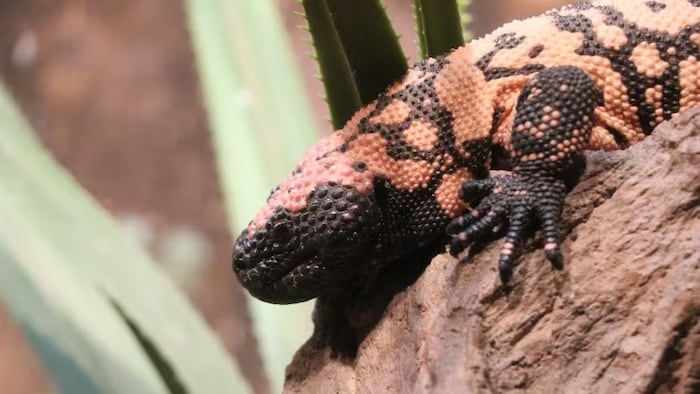Open in full screen mode The Gila monster, a species of venomous saurians, is believed to be a living relative of the fossil lizard discovered in Grande Prairie. Radio-Canada Speech synthesis, based on artificial intelligence, makes it possible to generate spoken text from written text. Paleontologists have discovered the remains of a prehistoric lizard dating back to the Cretaceous era in a bone bed near Grande Prairie in northern Alberta. This find, the results of which were described for the first time in an article (New window) (in English) published in November in the journal Geosciences , allows researchers to paint a more precise picture of the fauna and flora of the Grande Prairie region at that time. The discovery site is located not far from the bank of the Wapiti River, 11 kilometers from Grande Prairie. It is an ancient river bed that contains skeletal fragments of hundreds, if not thousands, of animals dating back to the late Cretaceous period, around 70 million years ago. /p> The bone site itself was discovered in 2014. Officially known as Wapiti Unit 3, it is home to a wide range of fossils and teeth from many species of prehistoric vertebrates, according to Corwin Sullivan, a paleontologist at the #x27;University of Alberta and co-author of the article. Most of the time when paleontologists find fossils, they come from larger animals, such as dinosaurs, notes Matthew Vavrek, a paleontologist in Grande Prairie. Also co-author of the article, he notes that small fossils are uncommon. Loading ELSE ON NEWS: Salary increases of 17.4% over five years for Common Front union members Matthew Vavrek says that small animals, such as lizards, turtles and crocodiles, played an important role in the prehistoric ecosystem, but because their bones were smaller, they did not preserve as well as those of larger animals. big. This means that researchers have little information about them. James Gardner is a paleoherpetologist at the Royal Tyrrell Museum in Drumheller. Gardner, who was not involved in the research, stresses the importance of understanding that ancient ecosystems, like modern ecosystems, are home to animals of different sizes. If you went to a modern environment here in Alberta, and you only looked at the largest animals, you would have things like the bison and the elk […]. But it would miss all the small mammals, notably birds, frogs, snakes, which are important elements of ecosystems. A quote from James Gardner, palaeoherpetologist, Royal Tyrrell Museum Lizard discovered could resemble a modern-day monitor lizard, says Matthew Vavrek. It measured about a meter long, says Corwin Sullivan. According to Mr. Vavrek, the lizard occupied an ecological niche similar to that of current animals of size similar. It fed on small prey. Corwin Sullivan also describes the area where the lizard lived as a humid and swampy forest. Collecting other fossil plants from the site will help scientists better understand the Cretaceous environment of Grande Prairie.< /p> With information from Dennis Kovtun
Wage increases of 17.4% over five years for Common Front union members
Rare fossils of Cretaceous-era lizard discovered in Alberta

